Creating a sales funnel that converts is essential for any business that wants to attract new customers. However, creating a sales funnel from scratch can be tricky if you don’t know where to start.
As a beginner, it’s vital to understand the four stages of a sales funnel. You can create one manually or by using a funnel builder. Once you start using a sales funnel, you can track results, adjust your digital marketing campaigns based on data, and improve the ROI of your marketing efforts.
If you’re a beginner, don’t worry. We’re going to walk you through the entire process of creating a sales funnel that converts. Once you have a basic funnel, you can adjust and improve it.
Understanding the Anatomy of a Sales Funnel
Before we get into the specifics of creating a sales funnel, let’s first take a look at the anatomy of a sales funnel.
Learning about this will help you understand what each part does and how it works.
We’ve covered this in detail on this blog, but a typical sales funnel will have four stages, popularly known as the AIDA framework:
- Attract
- Interest
- Decision
- Action
These are the stages that your prospects will typically go through before becoming a paying customers.
Therefore, creating a well-planned sales funnel depends on how well you can move your prospects through these four stages.
Let’s take a closer look at each stage. The better you understand them, the better your final funnel will be.
1. Attract – TOFU Content
The first step in any sales funnel is attracting your prospects.
During this stage, you are primarily concerned with attracting new visitors to your website and introducing them to your funnel.
To achieve this, you need to have a strategy to get them interested in what you are selling.
This could involve creating content that is relevant to their interests, running ads, or even networking with potential customers.
This is where top-of-the-funnel (TOFU) content comes in. TOFU content is designed to attract attention and introduce potential customers to your business.
This content is usually highly informative and educational. Popular examples of TOFU content include:
- Blog posts
- Infographics
- Web pages
- Social media updates
You can use your TOFU content to attract traffic from social media or search engines.
The goal is to get as many people as possible to your website so that you can introduce them to your business and begin the process of converting them into customers.
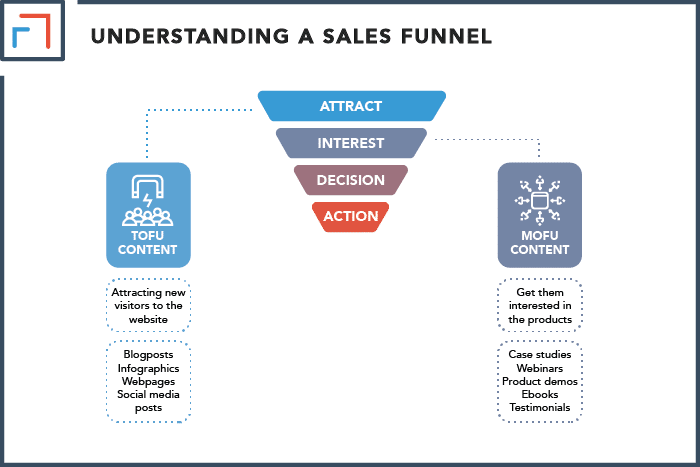
2. Interest – MOFU Content
Once you have attracted your prospects, it is time to get them interested in what you are selling.
This could involve offering discounts on products that they already like.
For instance, you could give away free samples of new items or send out emails about upcoming sales events.
This stage is where middle-of-the-funnel (MOFU) content becomes your best friend.
MOFU content is designed to build on the interest that was sparked by your TOFU content. This type of content usually includes things like:
- Case studies
- Ebooks
- Testimonials
- Webinars
- Product demos
- Any other forms of content that are relevant to your prospects
The goal here is to move your prospects from the awareness stage (which introduced them to what you are selling) into the consideration stage.
At this point, they should be aware of and interested in what you are offering. However, most of them are still not ready to make a purchase yet.
3. Decision – BOFU Content
The third step in any sales funnel is when your prospects make a decision.
This might involve them contacting you to learn more about what they want, filling out a form indicating their intent to purchase, or using a demo of your product/service.
At this stage in the funnel, you need to provide content that will help your prospects make a decision. This is known as bottom-of-the-funnel (BOFU) content.
BOFU content is designed to help your prospects understand the benefits of working with you and how your product or service can solve their problem.
It’s important to note that BOFU content should not be a pitch or an attempt to close the sale.
Instead, it should be educational and answer any questions your prospects may have about working with you or using your product/service.
When creating BOFU content, you’ll want to make sure it’s relevant to your target market and the stage of the funnel they’re in.
For example, you may have a case study to share with prospects who are interested in your services but aren’t sure if they’re ready to make a purchase.
Or, you could provide a free trial for prospects who have already expressed interest in your product.
Whatever type of BOFU content you create, make sure it’s helpful and relevant to your prospects.
This will help you close more sales and increase conversions from your funnel.
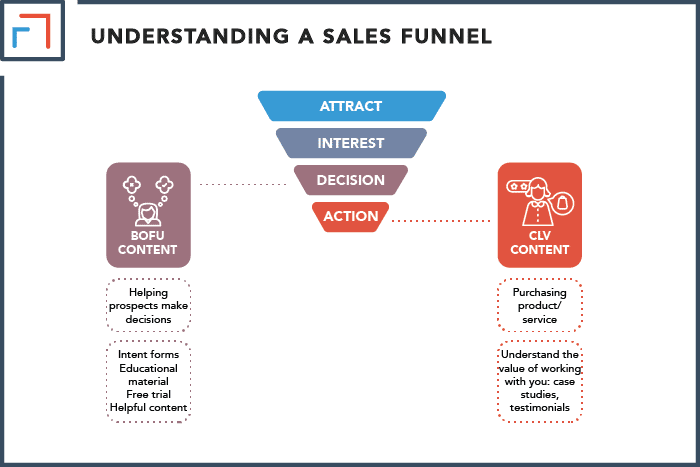
4. Action – CLV Content
The final step in any sales funnel is when your prospects take the desired action.
This could involve purchasing a product/service from you, signing up for a subscription, or even referring your business to their friends and family.
You need to provide content that encourages your prospects to take the next step during this stage. This is known as customer lifetime value (CLV) content.
CLV content is designed to help your prospects understand the value of working with you and how they can continue making purchases from your business for a long time.
This type of content could include case studies, testimonials, or other forms of content that highlight the positive results your products/services have had on other customers.
When creating CLV content, it’s important to remember that not all prospects will be ready to purchase from you right away.
Some may need more convincing or may want to see more evidence of your product/service’s value.
That’s why it’s best practice to create a variety of content that helps prospects at all stages of the funnel.
Doing this will increase your chances of making a sale and earning more revenue from each customer.
How To Create a Sales Funnel for Beginners?
To create a sales funnel as a beginner, start by identifying your target market. Then move on to identifying your funnel stage and creating content for each of those stages. Next, design your funnel well for a good user experience and experiment with formats. Finally, test and optimize your funnel.
Creating a sales funnel from scratch may seem like an overwhelming task, but it doesn’t have to be.
With the right tools and advice, you can create a funnel that converts casual visitors into customers.
Here’s a simple five-step process you can use to quickly and easily create your first sales funnel:
Step #01 – Identify Your Target Market
The first step in creating a sales funnel is identifying your target market.
This will help you determine who to focus on when creating your content and marketing campaigns.
Selling to the whole world won’t be as effective as targeting a specific group.
Consider the following questions when identifying your target market:
- Who will benefit from your products/services?
- What are their pain points?
- Where do they spend their time online (social media, email, etc.)?
- How old are they?
- What’s their gender and marital status?
- Do you want to focus on Business to Consumer (B2C) or Business to Business (B2B)?
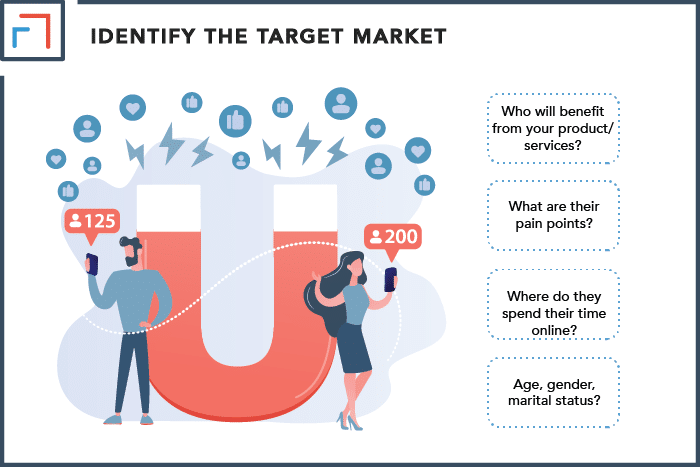
Step #02 – Identify Your Funnel Stage
The next step in creating a funnel is identifying the stage that best describes your prospects.
This will help you determine which type of content you need to make for each stage and what actions prospects should take once they reach it.
Consider the following questions when identifying your funnel stage:
- What is the problem your product or service solves?
- Does your target market know about this problem, and are they actively looking for a solution?
- Do you have a process in place to identify qualified prospects?
- Are you targeting the right people with your marketing message?
Once you’ve identified your funnel stage, it’s time to start creating content for each part.
Step #03 – Create Content for Each Stage of the Funnel
Creating content isn’t as hard as you might think. You can do it in a few simple steps, including:
- Brainstorming ideas for content
- Planning out your content calendar
- Creating the content
- Promoting the content
The type of content you create will vary depending on your funnel stage and target market.
However, some common types of content include blog posts, social media posts, e-books, webinars, and white papers.
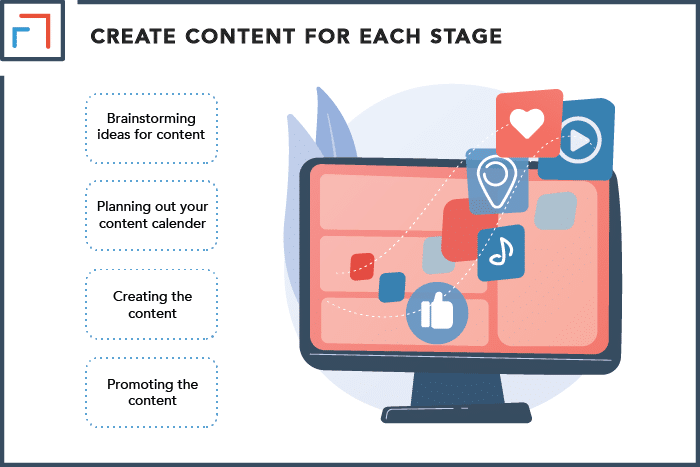
Step #04 – Design Your Funnel
Once you’ve created content, it’s time to design your funnel. This is where the fun begins!
Here are a few things to keep in mind when designing your funnel:
Choose the format that works best for you. There’s no right or wrong way to create a sales funnel.
So, don’t be afraid of experimenting with different formats until you find one that resonates with your customers and converts them into buyers.
Examples of popular sales funnel formats include the squeeze page funnel, tripwire funnel, and value ladder funnel.
There are several others, so look around and find the one that best matches your goals. Next, make sure your funnel is easy to navigate.
Your prospects should be able to easily move from one stage of the funnel to the next without getting lost or confused.
You should also test, test, test! Don’t launch your funnel until you’ve tested it on a small scale and made sure it’s working correctly.
Try different versions of your content to see which one performs better. You can do all of this manually or with the help of a tool like ClickFunnels or LeadPages.
Step #05 – Optimize Your Sales Funnel for Conversions
The final step in creating a funnel is optimizing it for conversions.
This means testing different aspects of your funnel to see which ones work best and then making adjustments accordingly.
For example, if you notice that most prospects leave your website after reading an article about your product, you might want to consider adding a call-to-action (CTA) button or popup to encourage them to stay.
Alternatively, if you notice that most prospects sign up for your email list but don’t buy anything, you might need to improve your sales pitch or create more targeted content.
The key is to constantly test and optimize your funnel to ensure that it’s converting as many prospects as possible.
According to the paper Design thinking: achieving insights via the “knowledge funnel”,
To advance knowledge, we must turn away from our standard definitions of proof – and from the false certainty of the past – and instead stare into the mystery of what could be.
Martin, R. (2010), “Design thinking: achieving insights via the “knowledge funnel””, Strategy & Leadership, Vol. 38 No. 2, pp. 37-41.
Creating a Sales Funnel the Manual Way – Time Consuming and Inefficient
The first way to create a sales funnel for your business is to do it manually.
Manual funnel creation involves creating a series of pages on your website to lead your visitors through the funnel.
Depending on your business, you will need to create a landing page, an opt-in page, a sales page, a thank-you page, etc.
You will also need to create a series of emails that you will send to your leads as they progress through the funnel.
To simplify the process, we have compiled an easy-to-follow list of steps.
Following along with these will help you create a successful sales funnel for your business website:
- Define your business goals and identify the key metrics you want to track.
- Create a customer profile that defines your ideal customer.
- Design a marketing campaign that will attract your target customers.
- Create a series of marketing and sales messages to persuade potential customers to buy from you.
- Create a landing page or website to capture leads and convert them into customers.
- Track the results of your marketing campaign and make necessary adjustments to improve your results.
- Repeat these steps until you achieve your desired results.
While it might be nice to fine-tune every element, this process can be time-consuming and is not very efficient.
It also requires a lot of technical knowledge and skills. There is an easier and more efficient way to create a sales funnel that we will discuss in the section below.
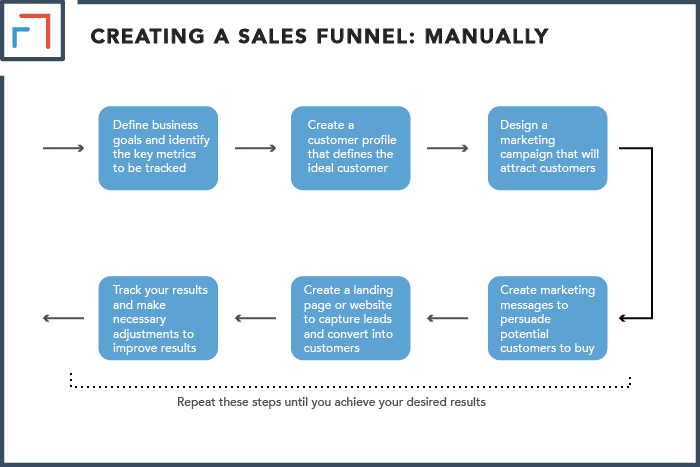
Creating a Sales Funnel with Software – Quick and Easy
The second way to create a sales funnel for your website is to use sales funnel software.
This method is quick, easy, and requires almost no technical knowledge or skills.
You can also use these tools to create landing pages, opt-in forms, sales pages, and thank-you pages.
Plus, they provide a variety of templates that you can use to get started quickly.
Here’s what you need to do:
- Choose a template from ClickFunnels or LeadPages that best suits your needs.
- Use their drag-and-drop editor to customize the design of your funnel and pages to match your branding. Then you can add your content.
- Next, integrate them with third-party services like MailChimp, GoToWebinar, and more.
Once you’ve completed these steps, your funnel will be ready to go!
There are several software programs available, like ClickFunnels and LeadPages, that will help you create a sales funnel for your business website.
These programs are easy to use and offer a great deal of flexibility.
However, it may take you some time to get acquainted with the software’s interface if you are a beginner.
Therefore, be patient and take the time to learn about all the options of your chosen funnel builder.
The best part of using sales funnel software and tools is that they are regularly updated with the latest features and design trends.
This means that you will always have access to new tools and templates to create a sales funnel that aligns with your branding and business goals.
The main downside of using a sales funnel software or tool is that they can be expensive.
However, the cost is worth it when you consider the time and money you will save by using them.
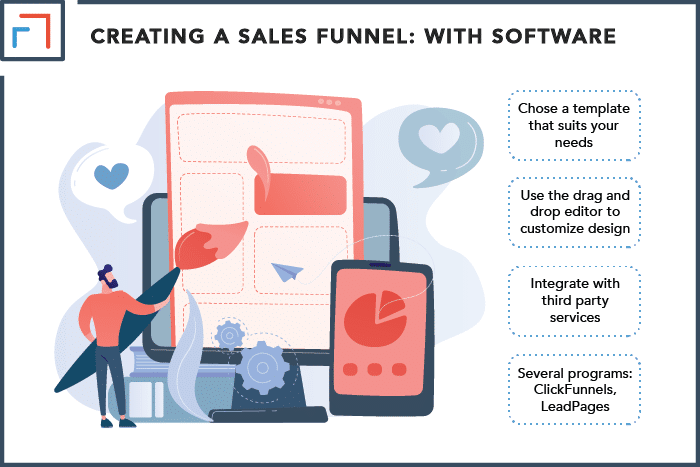
Tracking Results and Improving Your Sales Funnel
Once you have a sales funnel in place, it’s essential to track the results. Doing this will help you determine what is working and what needs to change.
So, how do you go about measuring your sales funnel?
1. Using Sales Funnel Analytics Data
You can use various tools to track the results of your marketing funnel, including Google Analytics, Kissmetrics, or Clicky.
You can use these tools to monitor the metrics that matter most to your business and track them over time.
For example, you may want to track the number of leads that enter your funnel, the conversion rate from leads to customers, and the average purchase amount.
This information will help you determine whether your sales funnel is effective or not.
If you find that your conversion rate is low or the average purchase amount is too low, you need to make changes in your funnel.
This may involve working on the optimization of your sales funnel.
For example, you could tweak the content or design of your pages or add/remove steps in your funnel.
2. Continue to Fix Leaks and Optimize Your Funnel
You also need to locate and fix every potential leak in the sales funnel.
For example, if you find that many people are dropping out of your funnel at a specific step, you need to identify what causes this problem and work on fixing it.
This is where data obtained from the sales funnel analytics tools will help you the most.
You should pay attention to every step in your sales funnel and work on improving it until you achieve your desired results.
You may also have to review your lead generation strategies or improve the effectiveness of your landing pages to close more leads into customers.
The beauty of using a sales funnel is that it’s a dynamic process. You can always make changes and improve your results.
So, don’t be afraid to experiment until you find the right formula for your business.
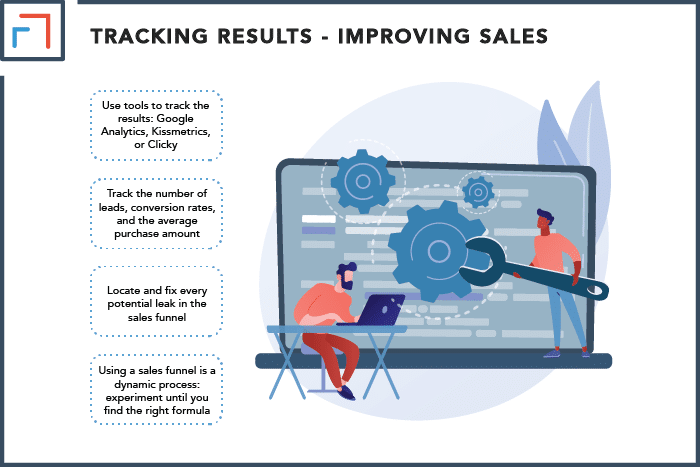
What’s Next?
Now that you know how to create a sales funnel for your business, it’s time to get started!
Choose the method that best suits your needs and start designing your funnel.
Remember to keep your business goals in mind and target specific customer groups when creating your funnel.
While creating a sales funnel takes some time and effort, the results are worth all the hard work!
